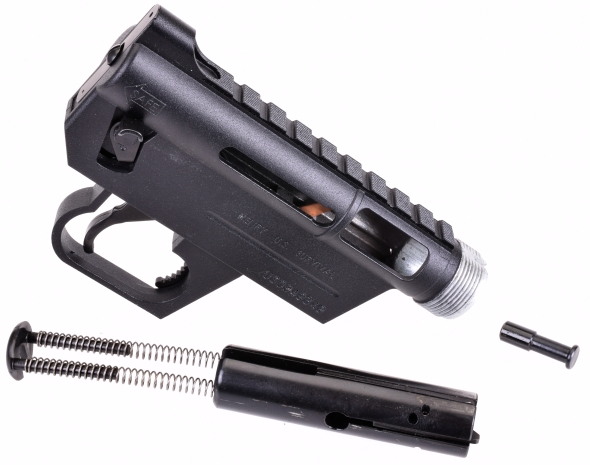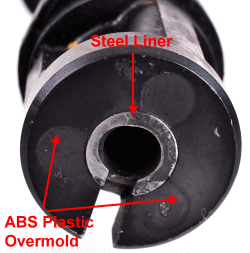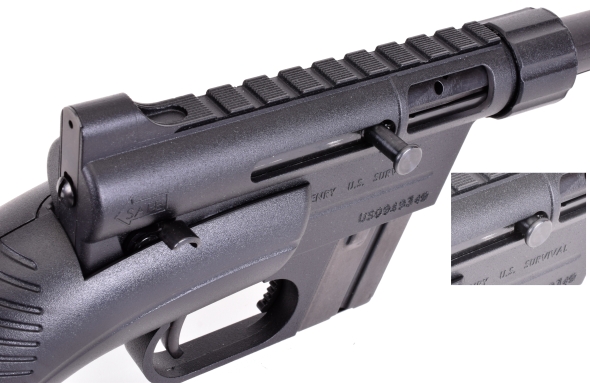 Based upon ArmaLite’s documentation of the history of the AR-7, the rifle was speculatively developed in 1959 by ArmaLite with the intent of selling it to the United States Air Force for use as a component of flight crew survival gear. With the Air Force still heavily inventoried with the M-4 22 Hornet bolt action and M-6 22 Hornet/410 bore O/U survival weapons, no more than a few AR-7s were ever sold to any branch of the U.S. military and the AR-7 rifle was never adopted for deployment.
Based upon ArmaLite’s documentation of the history of the AR-7, the rifle was speculatively developed in 1959 by ArmaLite with the intent of selling it to the United States Air Force for use as a component of flight crew survival gear. With the Air Force still heavily inventoried with the M-4 22 Hornet bolt action and M-6 22 Hornet/410 bore O/U survival weapons, no more than a few AR-7s were ever sold to any branch of the U.S. military and the AR-7 rifle was never adopted for deployment.
ArmaLite did sell a number of AR-7 rifles to the Israel Air Force, which were heavily modified before being placed into service. The ArmaLite AR-7 Explorer was produced in some numbers as a civilian product. In 1973 ArmaLite divested itself of civilian products and sold the AR-7 product to Charter Arms. Charter Arms was the primary civilian source for the AR-17 until 1980 when they sold the AR-17 to Henry Repeating Arms.
I am not sure how Henry got to the statement, “Since 1959, the venerable AR-7 has been the choice of U.S. Air Force pilots who need a small-caliber rifle they can count on for survival should they have to punch out over a remote area”. I am aware of no public record of the U.S. Air Force contracting for supply of these rifles and no ArmaLite document suggesting otherwise. Flight crew members do not choose survival gear, it is issued. During my association with B-52s, between 1966 and 1970, the only firearm I ever saw in a chute pack was the 22 Hornet M-4 and crew members typically carried handguns.
If Henry Repeating Arms, or anyone else for that matter, has credible documentation substantiating general deployment of this firearm for U.S.A.F. crew members, I would gladly revise my comments accordingly. For the time being at least, I was unable to find any record of the AR-7 being placed into general service as a United States Air Force flight crew survival rifle.
|
Henry U.S. Survival .22 |
|
| Manufacturer | Henry Repeating Arms |
| Origin | Bayonne, NJ |
| Model # | H002B |
| Action Type | Blow Back Semiauto |
| Caliber | 22 Long Rifle |
| Mag Capacity | 8 |
| Barrel Length | 16″ |
| Rifling | 1:16″ |
| Weight | 3.5 Lbs |
| Overall Length | 16.5″ / 35″ Assembled |
| Stock | Buoyant Hollow ABS Plastic |
| Action | Aluminum Teflon Coated |
| Barrel | Steel lined, ABS Plastic, Teflon |
| Length of Pull | 15.25″ (Not a Typo) |
| Sights | Adj. Dual Aperture – Ramped Front |
| Scope | 11mm grooved receiver top |
| Trigger Pull | 6 Lbs. 7 Oz. |
| Safety | 2 Position Thumb |
| MSRP | $290 |
| Take down rifle, all pieces with extra magazine stow in stock and assembly floats. | |
A few details…

With the stock cap removed, the stowed components are visible: receiver, barrel and two magazines. Below, components pulled for assembly. The receiver is slipped into the recess in the stock, the stock takedown nut and screw (center of pistol grip cap) are tightened to secure the receiver then the barrel is keyed to the receiver and the barrel nut is tightened to secure that part of the assembly.


Disassembly for cleaning is very simple. The magazine is pulled, the chamber is checked for empty and assembly steps are reversed. The bolt is pulled by poking a finger into the open receiver and applying pressure to the bolt face to remove the preload from the rifle’s charging handle. The charging handle is pulled from the bolt and the bolt assembly is eased forward and out of the receiver with the action spring guide and guide springs.

The AR-7’s receiver is a quality aluminum casting of significant wall thickness. The oversize bolt is steel with a single extractor and dual guide springs that make for smooth, nonbinding movement. Both the receiver and barrel receive a Teflon coating for easy wipe down cleaning. I think the finish is a nice touch, however, I am not sure I’m ready to climb aboard with the Henry statement, “The receiver is also coated with Teflon™ for superior weatherproofing and waterproof protection, even in harsh saltwater environments. The inside of the receiver is bare aluminum, the breech face is bare steel and while the Teflon may provide some surface protection, there is nothing that seals or waterproofs the interior of the firearm.
 The barrel is a composite piece comprised of an 0.050″ thick steel liner, overmolded with ABS plastic which keeps the rifle’s weight low despite the thin steel and plastic construction, the barrel is actually quite rigid.
The barrel is a composite piece comprised of an 0.050″ thick steel liner, overmolded with ABS plastic which keeps the rifle’s weight low despite the thin steel and plastic construction, the barrel is actually quite rigid.

The AR-7 is supplied with two stamped steel magazines, each with an 8 shot capacity. As the rifle’s breech face is flat, the front of the magazine is formed as a feed ramp. Both 8 and 15 round inexpensive magazines are readily available from third party suppliers.
Barrel to stock offset…

The barrel appears oddly aligned to the buttstock assembly, however, because the buttstock is oversize at 2 3/4″ in width to make the assembly buoyant, the offset of the barreled action is actually well aligned for shooting.
Sight system
The sight system is an excellent example of minimalistic or simplistic design. The stamped steel rear peep sight has two apertures. 0.045″ and 0.080″ and is flipped to change from one to the other. The slotted cut at the center screw location allows elevation adjustment.

The ramped front sight is serrated to kill reflection and the high visibility orange blade is dovetail mounted to facilitate windage adjustment. The top receiver rail is cross slotted and has the appearance of a Picatinny rail, however, it is an 11mm rimfire standard rather than an approximately 21mm Picatinny rail. Still, it is a good mounting surface for a scope or red dot sight.

The controls are conveniently placed. The charging handle pushes in to stay out of the way when not needed, the two position thumb safety is a little sloppy in detent, the trigger pull is a little heavy but crisp. Magazine release and retention is positive.
Shooting personality…
From the standpoint of shooting comfort, despite the AR-7’s somewhat bulbous stock and long pull it is actually comfortable to shoot. Sight alignment is quite natural, face support is good and gripping the front of the receiver and magazine in the absence of a forearm results in a very steady off hand hold.

The Henry manual makes a number of references to using high velocity ammo and spending the time to find the best for the AR-7. Six types of ammo were tried and all shot between 1″ and 1.5″ at 25 yards. The 1″ group, above left, was shot with standard velocity Peters 40 grain. The 1.5″ group, above right, is a 16 shot group shot with two magazines of mixed ammo. There were no flyers and the gun shot the same cold or hot. Shooting through aperture sights, this is good accuracy for a rifle of this type and for this purpose.
With Henry’s caution to use only high velocity, and the usual flock of Internet one-up parroting of cycling problems, more ammunition was expended than planned in search of a problem. If there was a problem or ammunition sensitivity, my usual lackadaisical approach to rimfire ammo selection should have caused it to surface. The following was fired through the AR-7.
| 22 LR Ammunition | Bullet Weight Grains |
Rated FPS |
| Remington Eley Target | 40 | 1050 |
| Winchester Super X HP | 26 | 1650 |
| Remington Subsonic HP | 38 | 1050 |
| Remington Thunderbolt | 40 | 1255 |
| Peters High Velocity | 40 | 1255 |
| Remington High Velocity | 40 | 1255 |
If there is a need to use only high velocity ammo, or if there is a feeding problem, it didn’t show up for me. The AR-7 basically ingested loaded ammo and spit out empties from at least a full box of each ammo type indicated. After some quick cleaning another 100 rounds or so of magazines filled with mixed ammo types were fired. That range of subsonic to hyper velocity is a good stretch for any semi auto rimfire to handle.
Conclusions
The Henry U.S. Survival AR-7 Rifle is a reliable firearm with decent accuracy and well finished for a utility firearm. As a firearm where buoyancy is of consequence, the AR-7 may be a good product and perhaps the only product of its type. However, after removing the stock cap a few times, its fit loosened and clearly would not be water tight if submerged or bounced around a bit in the water.
As a takedown firearm to facilitate backpacking or travel, there are other takedown autoloaders; $699 Browning Semi-Auto 22, $328 Marlin 70 PSS Papoose, $399 Ruger 10/22 Takedown. The $290 AR-7 is less costly, but the other rifles have traditional stock geometry and pull length and more commonly, a higher degree of accuracy.
If flotation and takedown features are not a priority, there are many semiauto rimfire rifles with a list price $100 less; $181 Mossberg Bantam Plinkster, $175 Savage 64F, $183 Marlin 795, $191 Ruger 10/22, etc.
For me, the AR-7 is a bit of a marketing gimmick, over priced and without significant benefits. While it cycles reliably and has decent accuracy, I would question the longer term durability of the steel lined ABS overmolded barrel.

Email Notification